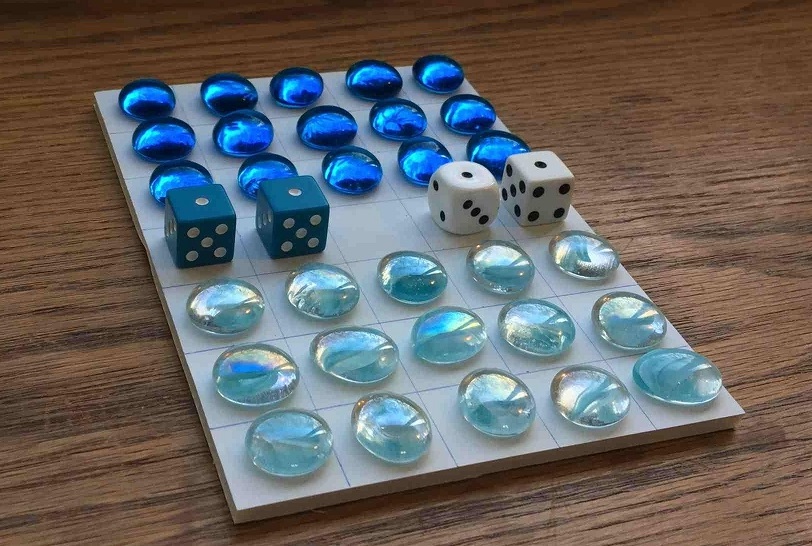

Development:
I was pondering the old Korean game
four field kono.
This is an awful
game with an intriguing type of capture.
Actually I forgot and misinterpreted the capture;
I thought you jump over an
opponent to land on a second opponent.
So what if you combined (my interpretation of) the
four field kono capture
for some pieces plus other pieces that do capture by jumping over, like
checkers? You make holes in formations, then have the pawns take
advantage of that.
This quickly switched to chess knights and a bunch of pawns on each of
the two teams. I never did try four field kono capture.
The pawns have unique rules. The board is smaller.
I tried several different setups and board dimensions, but just wound
up back with the original idea, which is a 7 x 5 board and a
Dablot Prejjesne setup.
The gameplay for bilsang is interesting, and I played it many times.
However, the ending is dreary, and surprisingly even.
The game needed a goal other than attrition. I tried getting pieces
to the other side of the board, or planting yourself on the centre cell,
or an attrition points system. As of writing, the goal is to take a ball from the centre position. You aren't really taking it somewhere;
the game ends when one player can not take possession of the
ball and resigns.
The ball was a dime. The hidden dime is awkward and extra work to move around. I changed this - now called a crown - to an invisible piece.
Bilsang (I never could figure out if these names are capitalised) is a meaningless word. I had the name kicking around forever as a folder name for a game that is long gone and forgotten. I remember it as being exciting but a failure in the end. I've run through so many game ideas that I can forget what I've done. This might be similar to the original rules for bilsang. A glitch in the matrix there.
Bilsang has what I call the A/B issue. Most of the pieces are on A rows, with a minority of the pieces on B rows. In practise it is not a problem.
It's called Bilsang until I realise that's a stupid name.
Components:
The pawns are little glass pieces.
I got the blue plus mostly clear turquoise glass pieces from Michael's (years ago).
The knights are dice, which you can get from a game store or dollar store.
You can get a pretty little white bag for the pieces at Michael's, in the
wedding section. I'm told dollar stores have them too.
All this goes on a tightly-packed 5 x 7 grid on a little
5 x 7 inch board.
The board is made from posterboard. Cut it with a utility knife
and a metal ruler. Posterboard does not work for other games, but it works for this.
Instead of posterboard you can use ordinary paper.
Use an ordinary blue pen for the lines.
The crown is invisible.
When your piece has a crown you turn it upside down.
A die which would normally have a 1 on top would have a 6 on top.
Rules:
A player wins bilsang when the opponent can not have possession of the crown and resigns.
The board is a 7 x 5 grid.
Pieces include pawns (glass pieces) and knights (dice).
The blue player moves the 15 blue pawns and two blue knights,
while the white player moves the 15 white pawns and two white knights.
The game is set up as shown in the picture
below.
The dice have ones on top. The crown begins in the centre cell.

The crown is invisible. If a piece lands on the crown or captures a piece that has the crown, the moving piece now possesses the crown. This is shown by turning the piece upside down. When a piece that has the crown moves, the crown moves with the piece.
The two players take turns moving one of their pieces. A piece must be moved during a turn. If a move is made it can not be taken back, and if a piece is touched it must be moved.
The two types of pieces have
different types of capture, as though they are from two
different games.
Moves can not be blocked, except a piece can not land on a friendly
piece.
Knights move like chess knights,
two spaces orthogonally (not diagonally)
and one space perpendicular to that. If a knight lands on an opponent's
piece, the piece is captured and removed from the board.
Pawns move exactly two spaces orthogonally.
If a pawn jumps over an opponent's piece, that piece
is captured.
What gameplay is like:
The action starts right away, although the beginning is a bit boring. Pawns work differently than other games. A game does not last long.
The game involves struggles in the top and bottom of the board where knights and pawns attempt to eliminate each other. Pieces generally don't threaten other pieces of the same type. At the beginning the knights tear through the pawns. As spaces are opened up the knights become vulnerable. At the end there can be spaces between pawns and they can't protect each other, but the game is just about to end at that point.
You're generally concerned with capturing and surviving; you kind of forget about the crown. Players will focus too much on trying to take out another pawn, so the game involves stupid moves followed by instant regret, hence the tough rules for moves.
The game is not very complex. There must be catch up mechanisms because the two
players will be surprisingly even through the game. You can still keep on fighting
after losing a knight. Although the game is not very complex, there are decisions to be
made, and this continues steadily through the game. That makes it likeable.
Pictures:

Setup. Note the ones on top of the dice, and the invisible crown in the middle.
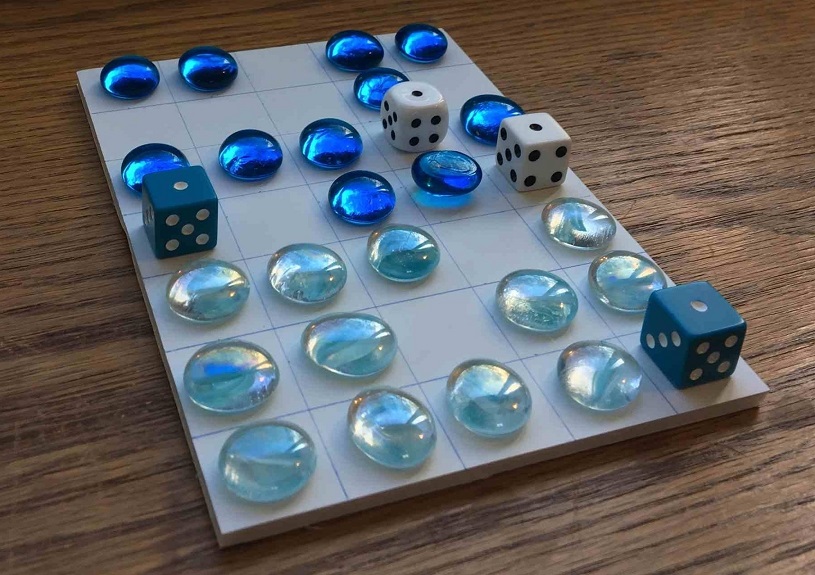
Blue's turn. One of the blue pieces has the crown.
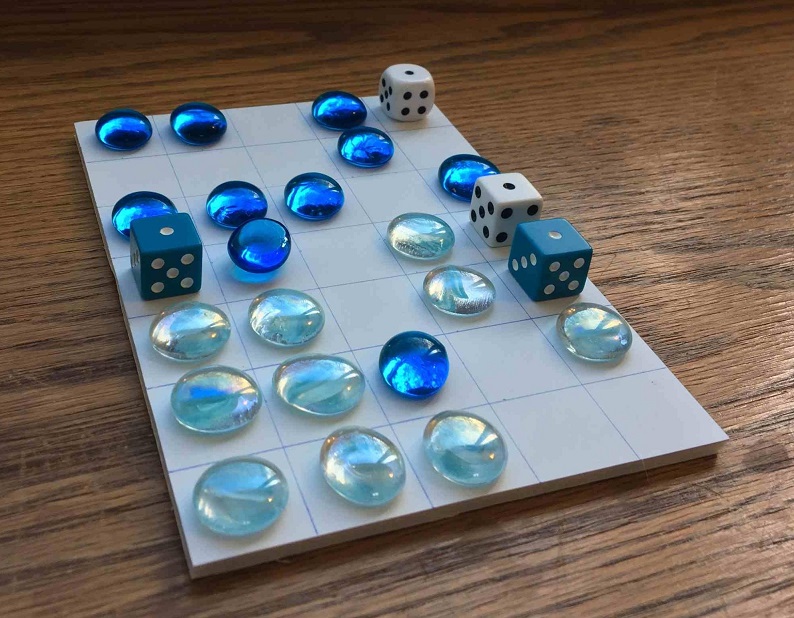
white's turn
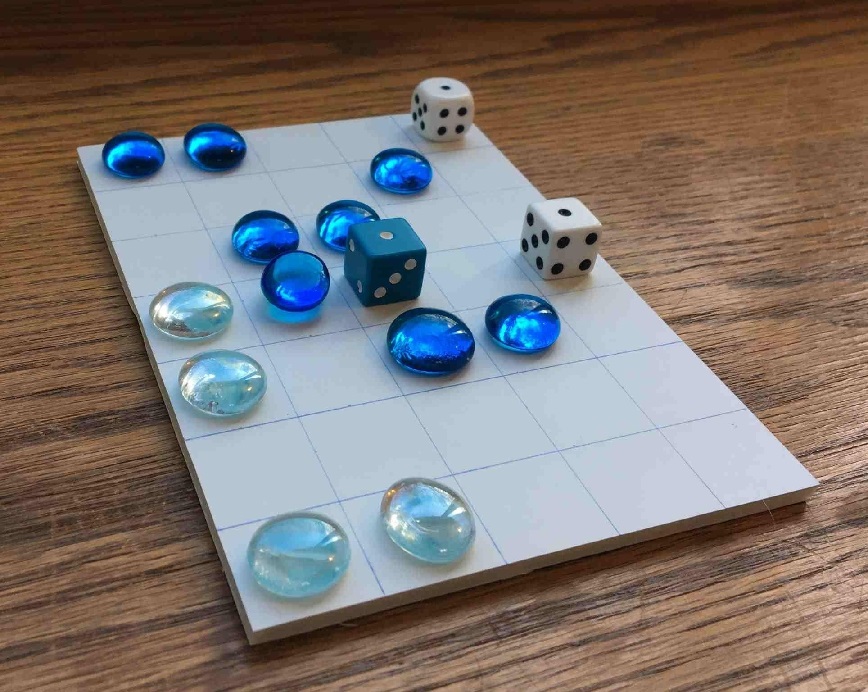
blue's turn
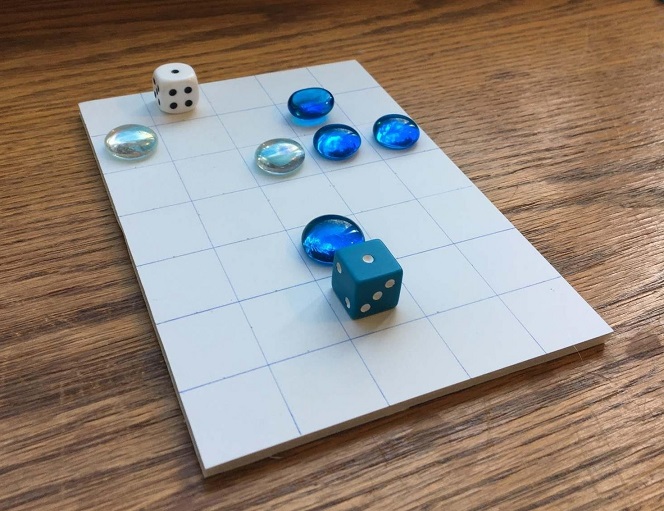
white resigns
How good is this game?
My opinion has wobbled, but sometimes I say it is my favourite game.
I keep playing it over and over and over, so it clearly works for me.